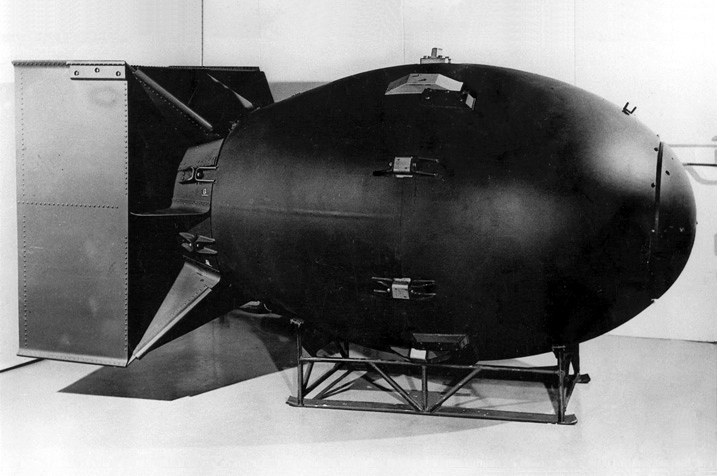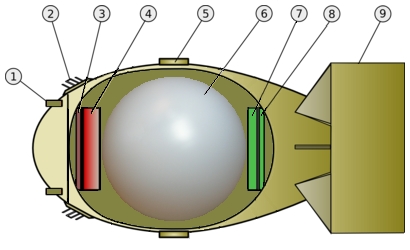"Fat Man" is the codename of the atomic bomb that was detonated over Nagasaki, Japan, by the United States on August 9, 1945. It was the 2nd of the two nuclear weapons to be used in warfare. The name also refers more generically to the early nuclear weapon designs of U.S. weapons based on the "Fat Man" model. It was an implosion-type weapon with a plutonium core.
"Fat Man" was detonated at an altitude of about 1,800 feet (550 m) over the city, and was dropped from a B-29 bomber Bockscar, piloted by Major Charles Sweeney. The bomb had a yield of about 21 kilotons of TNT, or 8.78×1013 joules = 88 TJ (terajoules).[1] Because of Nagasaki's hilly terrain, the damage was somewhat less extensive than that in relatively flat Hiroshima. An estimated 40,000 people were killed outright by the bombing at Nagasaki, and about 25,000 were injured.[2] Many thousands more would die later from related injuries, and radiation sickness from nuclear fallout.
Technology
The weapon was 10 feet 8 inches (3.25 m) long, five feet (1.52 m) in diameter, and weighed 10,200 pounds (4,630 kg). In accordance with the name, it was more than twice as wide as Little Boy, which was dropped on Hiroshima three days earlier; however, the mass was only 10% more.
"Fat Man" was an implosion-type weapon using plutonium. A subcritical sphere of plutonium was placed in the center of a hollow sphere of high explosive. Numerous detonators located on the surface of the high explosive were fired simultaneously to produce a powerful inward pressure on the core, squeezing it and increasing its density, resulting in a supercritical condition and a nuclear explosion.
The difficulty in the design lay primarily in properly compressing the plutonium core into a near-perfect sphere; if the compression was not symmetrical it would cause the plutonium to be simply ejected from the weapon, making it an inefficient and un-impressive "dirty bomb". In order to accomplish the compression, the high-explosive system had to be carefully designed as a series of explosive lenses which used alternating fast- and slow-burning explosives to shape the explosive shockwave into the desired spherical shape. An early idea of this sort had been raised by physicist Richard Tolman during early discussions of possible bomb designs, though Seth Neddermeyer is credited for developing the idea further. The idea of using shaped charges came from mathematician John von Neumann, and both he and George Kistiakowsky eventually ended up being the principal architects behind the lens system. Robert Christy is generally credited with the insight that a solid subcritical sphere of Plutonium could be compressed to a critical state greatly simplifying the task since earlier efforts had attempted the more difficult compression of shapes like spherical shells. Because Christy's insight made the feasibility of a Plutonium bomb much more likely, the weapon tested at Alamagordo and used at Nagasaki is sometimes referred to as the "Christy Gadget."

At first it was thought that two pieces of subcritical plutonium (Pu-239) could simply be shot into one another to create a nuclear explosion, and a plutonium gun-type design of this sort (known as the "Thin Man" bomb) was worked on for some time during the Manhattan Project. However in April 1944 it was discovered that plutonium created for the bomb in the nuclear reactors at Hanford, Washington—even though it was supergrade weapon plutonium containing only about 0.9% Pu-240—was not as pure as the initial samples of plutonium developed at the cyclotrons at Ernest O. Lawrence's Radiation Laboratory in Berkeley, California. Because of the presence of the isotope Pu-240, reactor-bred plutonium had a much higher rate of spontaneous neutron emission than was previously thought, and if a gun-type device was used it would most likely pre-detonate and result in a messy and costly "fizzle." The spontaneous fission rate of Pu-240 is 415,000 fissions/(s·kg), and the amount was 0.9% of 6.2 kg, is 56 g. Thus there were 23,000 spontaneous fissions per second. This means that the last few centimeters would have to be travelled in preferably much less than 40 microseconds.
It is theoretically possible to build a plutonium gun-type device, but it would need to be 19 feet long in order to accelerate the subcritical masses sufficiently to be fused into a critical mass before a fizzle occurs. The mass of a plutonium gun-type device would have been beyond the payload of the B-29.
After this problem was realized, the entire Los Alamos laboratory re-organized around the problem of the implosion bomb, the "Fat Man" starting in June 1944.
The gun-type method could still be used for highly enriched uranium, though, and was employed in the "Little Boy" weapon, which was used against Hiroshima, Japan. For a variety of reasons, the implosion method is both more efficient than the gun-type method, and also far safer, as a perfect synchronization of the explosion lenses is required for the core to properly detonate, greatly reducing the chances of an accidental nuclear detonation.

Because of its complicated firing mechanism, and the need for previously untested synchronization of explosives and precision design, it was felt that a full test of the concept was needed before the scientists and military representatives could be confident it would perform correctly under combat conditions. On July 16, 1945, a device utilizing a similar mechanism (called the "gadget" for security reasons) detonated in a test explosion at a remote site in New Mexico, known as the "Trinity" test. In the end, it gave somewhere around 20 kt (80 TJ), 2 to 4 times the expected yield.
The Soviet Union's first nuclear weapon detonated at Operation First Lightning (known as "Joe 1" in the West) was more or less a purposeful copy of the "Fat Man" device, on which they had obtained detailed information from the spy Klaus Fuchs.
The names for all three projects ("Fat Man", "Thin Man", and "Little Boy") were created by Robert Serber, a former student of Los Alamos director Robert Oppenheimer's who worked on the project. According to his later memoirs, he chose them based on their design shapes; the "Thin Man" would be a very long device, and the name came from the Dashiell Hammett detective novel and series of movies by the same name; the "Fat Man" bomb would be round and fat and was named after Sidney Greenstreet's character in The Maltese Falcon. "Little Boy" would come last and be named only to contrast to the "Thin Man" bomb.[3]
Interior of bomb
The original blueprints of the interior of both Fat Man and Little Boy are still classified. However, much information about the main parts is available in the unclassified public literature. Of particular interest is a description of Fat Man sent to Moscow by Soviet spies at Los Alamos in 1945. It was released by the Russian government in 1992.[4]
Below is a diagram of the main parts of the "Fat Man" bomb itself, followed by a more detailed look at the different materials used in the physics package of the bomb (the part responsible for the nuclear detonation).
|
Physics package
Assembly
To allow insertion of the plutonium pit as late as possible in the bomb's assembly, the spherical U-238 tamper had a 4" diameter cylindrical hole running through it, like the hole in a cored apple. The missing cylinder, containing the plutonium pit, could be slipped in through a hole in the surrounding aluminum pusher. In August of 1945, it was assembled on Tinian Island. When the physics package was fully assembled and wired, it was placed inside its ellipsoidal aerodynamic bombshell and wheeled to the bomb bay of a B-29 named "Bockscar" for its flight to Nagasaki on August 9.
In 2003, these concentric spheres and cylinder were recreated as the centerpiece of an art installation called "Critical Assembly" by sculptor Jim Sanborn. Using non-nuclear materials, he replicated the internal components of the "Trinity" bomb, which had the same design as Fat Man. Critical Assembly was first displayed at the Corcoran Gallery of Art, in Washington, DC.[5]
Detonation sequence
The plutonium must be compressed to twice its normal density before free neutrons are added to start the fission chain reaction:
- An exploding-bridgewire detonator simultaneously starts a detonation wave in each of the 32 tapered high explosive columns (12 pentagonal and 20 hexagonal - in the pattern of a soccer ball skin).
- The detonation wave (arrows) is initially convex in the
- faster explosive, Composition B: 60% RDX, 39% TNT, 1% wax. Its shape becomes concave in the
- slower explosive (Baratol). The 32 waves merge into a single spherical implosive wave before they hit the
- faster explosive, Composition B, of the inner charges.
- The medium-density aluminum "pusher" transitions the imploding shock wave from low-density explosive to high-density uranium, minimizing undesirable turbulence; the shock wave then compresses the inner components. At the very center, the
- beryllium–polonium-210 "initiator" (the "urchin") is crushed, bringing the two metals in contact to release a burst of neutrons into the compressed
- "pit" of plutonium-239–plutonium-240–gallium delta-phase alloy (96%–1%–3% by molarity). A fission chain reaction starts. The tendency of the fissioning pit to prematurely blow itself apart is retarded by the inward momentum of the
- natural-uranium "tamper" (inertial containment). The tamper also reflects neutrons back into the pit, speeding up the chain reaction.
- The boron plastic shell was intended to protect the pit from stray neutrons, but was later deemed unnecessary.
The result is the fissioning of about two and a half of the thirteen pounds of plutonium in the pit, and the release of twenty-one kilotons of energy (21,000 tons of TNT).








没有评论:
发表评论